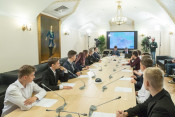
A meeting in the Presidential Library spotlighted the work of plants and factories in the Russian Empire in the 19th century
The Knowledge of Russia video lecture, the fourth lecture within the series “Regions of the Russian State in the 18th – early 20th centuries” was held in the Presidential Library. The meeting was dedicated to the industrialization in the Russian Empire, which begun in the late 19th century. A well-known specialist in the field of economic history and the history of banking, PhD in History, Sergey Lebedev, delivered a lecture on this subject.
The event in the Presidential Library brought together students of the Herzen State Pedagogical University of Russia, representatives of the Tsarskoye Selo Museum-Reserve, and senior pupils of school no 543 inMoskovsky District, St. Petersburg. Specialists of the Pushkin Omsk State Regional Research Library joined the discussion via videoconferencing.
The historian, in particular, highlighted the economic specialization of certain regions of the Russian Empire at the end of the 19th century. Thus, Kharkov used to be “in charge of” sugar production, Odessa was the country's main port for exporting wheat, while rye was exported to Northern Europe via the ports of Riga and St. Petersburg.
Sergey Lebedev noted that many geographical names in the above-mentioned cities, such as Peresyp – a famous district in Odessa, were associated with economic specialization in the past.
Sergey Lebedev’s lecture also touched upon the regions and cities that are now part of foreign countries. In addition to the developed Petersburg and Moscow industrial regions, the second half of the 19th century witnessed particular rapid economic growth in the Baltic countries and modern Poland (within the Russian Empire).
The lecture was partly dedicated to one of the largest national metallurgical enterprises - the Hughes factory, which began regular smelting of cast iron in 1872, and in 1876 its production reached 1.5 million poods (a Russian unit of weight) - a very impressive figure for that time.
The Presidential Library’s electronic collections feature rare materials, which spotlight the economic history of the Russian Empire, foreign trade, monetary circulation, agricultural problems, etc.
The lecture also dealt with industrialization in general, features of this process at different times and in different countries, as well as the development of the global financial system over the past two centuries and Russia's place in it.
The historian focused particular attention on Sergey Witte (1849–1915), Minister of Finance of Russia in 1892–1903. A lot of materials devoted to this reformer are available in the Presidential Library’s collections. They include a study by historian V. Vodovozov Count S. Yu. Witte and Emperor Nicholas II (1922) and P. B. Struve’s work Count S. Yu. Witte (1915). A thematic webinar dedicated to the contribution of Sergey Witte to the development of the Russian state at the turn of the 19th – 20th centuries was recently held at Senate Square, 3. Visitors to the Presidential Library also have an opportunity to see photographs of Sergey Witte, including works of the famous court photographer Karl Bulla of 1892 and 1903.





